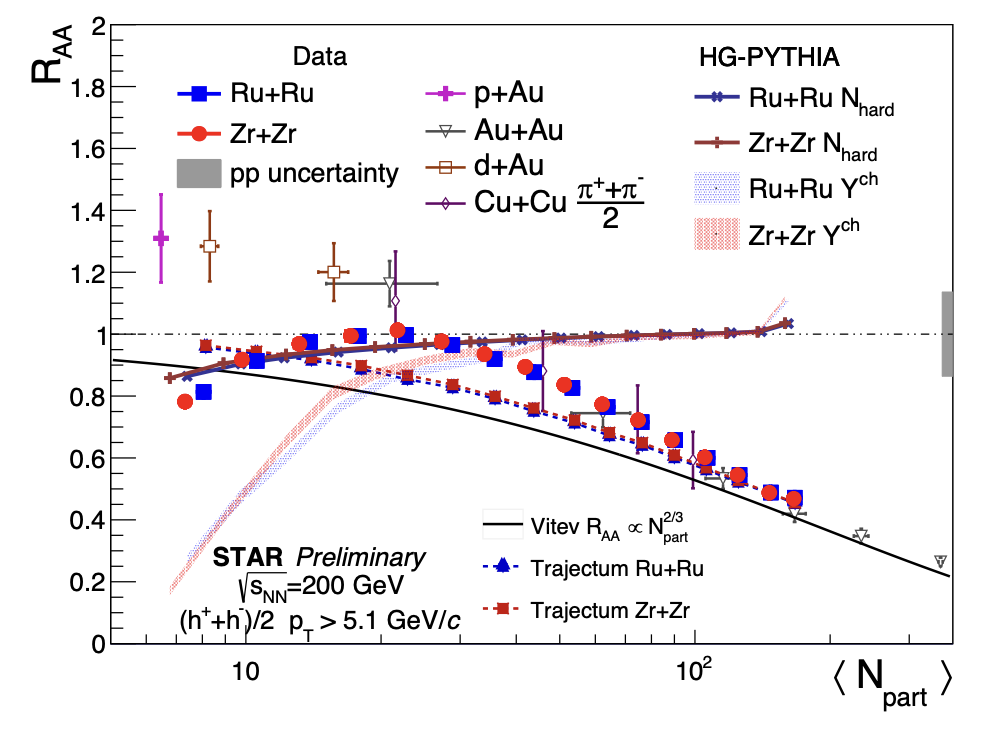Paper proposal: Inclusive Hadron Yield Analysis in Small and Mid-sized Collision Systems at s_nn=200 GeV at STAR
Title: Inclusive Hadron Yield Analysis in Small and Mid-sized Collision Systems at s_nn=200 GeV at STAR
PAs: Tong Liu (Yale), Helen Caines (Yale), Rongrong Ma (BNL), Maowu Nie (SDU), Li Yi (SDU)
GPC:
Target journal: PRC
Abstract: In this paper, we report measurements of charged hadron yields and the nuclear modification factor Raa /Rpa in Ru+Ru, Zr+Zr and p+Au collisions at s_nn=200 GeV with the STAR detector at RHIC. In p+Au collisions, an enhancement relative to p+p yields is reported. In Ru+Ru/Zr+Zr collisions, significant suppression is seen in central collisions, which gradually weakens moving to more peripheral collisions. The magnitude of this nuclear suppression factor at sqrt(s_NN) =200 GeV is shown to depend linearly on the number of participants in the collision, independent of species collided. Finally, it is demonstrated that an apparent increase in the suppression in the most peripheral collisions is due to a geometric bias, and the implications of this bias are discussed using the Glauber model.
PWGC Review: link
Analysis note: link
Paper draft:
proposed figures:
Fig.1: Corrected inclusive hadron spectra for inclusive p+Au, EA-differential Zr+Zr, Ru+Ru and Au+Au collisions from 0.4-10 GeV/c
.png)
Fig.2: Raa for inclusive p+Au, EA-differential Zr+Zr, Ru+Ru and Run 19 Au+Au collisions from 0.4-10 GeV/c
.png)
Fig.3: Ru+Ru vs Zr+Zr yield ratio, raw per-event yield, Ncoll scaled and Npart scaled.

Fig.4: Raa vs Npart for Ru+Ru, Zr+Zr, Run 19 Au+Au, Run 3 Au+Au, Cu+Cu, and d+Au, as well as HG-Pythia, Vitev and Trajectum results.

Main physics message:
1. In large collision systems of Npart>20, the suppression shown for high-pt hadrons is dominated by Npart.
2. In small collision systems (p+Au and d+Au), initial-state effect overwhelms the suppression, and enhancement is shown in these collisions.
3. Peripheral isobar collisions exhibits apparent suppression due to geometric bias caused by a flaw in the Glauber model.
4. For the same centrality percentage, Ru+Ru produces a larger collision system than Zr+Zr.
Related links:
https://drupal.star.bnl.gov/STAR/theses/PhD-116
https://drupal.star.bnl.gov/STAR/blog/tongliu/Tong-Lius-HP-PWG-updates
https://drupal.star.bnl.gov/STAR/blog/tongliu/QM2022-Prelim-Plot-Request-0
https://drupal.star.bnl.gov/STAR/blog/tongliu/dnp2021-preliminay-plot-request
- tongliu's blog
- Login or register to post comments
